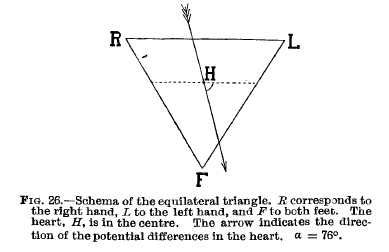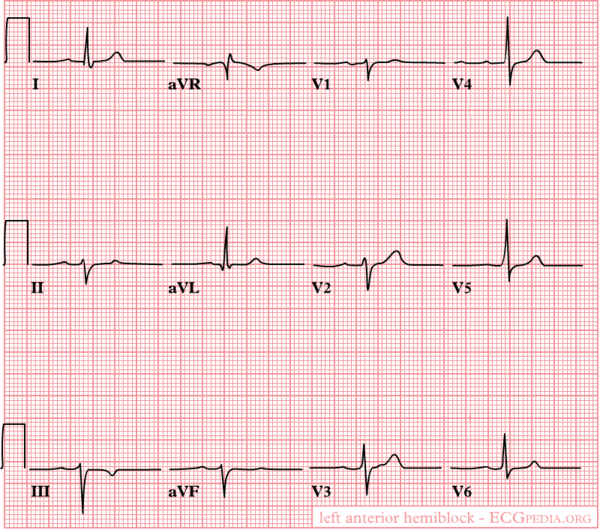QRS axis: Difference between revisions
No edit summary |
No edit summary |
||
| Line 31: | Line 31: | ||
This indicates a normal heartaxis. Usually, these two leads are enough to diagnose a normal heartaxis! | This indicates a normal heartaxis. Usually, these two leads are enough to diagnose a normal heartaxis! | ||
The biggest vector in the heart is from the AV-node in the direction of the ventricular depolarization. | The biggest vector in the heart is from the AV-node in the direction of the ventricular depolarization. Under normal circulstances, this is directed left and down.(towards leads I and AVF). The position of the QRS vector is given in degrees. See the figure, the middle of the figure is the AV-node. A horizontal ine towards the left arm id defiuned as 0 degrees. | ||
A normal heartaxis is between -30 and +90 degrees. | |||
'''Rule:''' biggest QRS deflection in I and II is an intermediate = normal heartaxis. | |||
So positive deflections in I and II indicates a normal heartaxis. | |||
{{clr}} | {{clr}} | ||
==== | ====Interpretation==== | ||
De interpretatie van de elektrische hartas kent een aantal makkelijk te onthouden regeltjes: | De interpretatie van de elektrische hartas kent een aantal makkelijk te onthouden regeltjes: | ||
Revision as of 17:39, 20 May 2007
Some statements may be disputed, incorrect or biased. |
| Author(s) | I.A.C. van der Bilt, MD | |
| Moderator | I.A.C. van der Bilt, MD | |
| Supervisor | ||
| some notes about authorship | ||
What is the electrical heartaxis?


The electrical heartaxis is an average of all depolarizations in the heart. The depolarization wave begins in the right atrium and proceeds to the left and right ventricle. Because the left ventricle wall is thicker than the right wall, the arrow indicating the direction of the depolarization wave is directed to the left.
For a lot of people, this is a difficult concept. The theoretic part seems difficult but by doing it a lot, it will become clear.
How do you determine the electrical heartaxis


When you average all electrical signals from the heart, you can indicate the direction of the average electrical depolarization with an arrow (vector). This is the heartaxis. Especially a change of the heartaxis or an extreme deviation can be an indication for pathology.
For example:
- Biggest QRS deflection in lead I: the electrical activity is directed to the left (of the patient)
- Biggest QRS deflection in lead AVF: the electrical activity is directed down.
This indicates a normal heartaxis. Usually, these two leads are enough to diagnose a normal heartaxis!
The biggest vector in the heart is from the AV-node in the direction of the ventricular depolarization. Under normal circulstances, this is directed left and down.(towards leads I and AVF). The position of the QRS vector is given in degrees. See the figure, the middle of the figure is the AV-node. A horizontal ine towards the left arm id defiuned as 0 degrees.
A normal heartaxis is between -30 and +90 degrees.
Rule: biggest QRS deflection in I and II is an intermediate = normal heartaxis. So positive deflections in I and II indicates a normal heartaxis.
Interpretation
De interpretatie van de elektrische hartas kent een aantal makkelijk te onthouden regeltjes:
- Ten eerste, beweegt een positieve depolarisatiegolf naar een positieve elektrode, dan wordt er een positieve, naar boven gerichte uitslag op het ECG geregistreerd.
- Ten tweede zijn er 4 gebieden waar de QRS-vector naar kan wijzen:
- linksboven --> linker asdraaing (tussen -30º en -90º)
- linksonder --> normaal gebied (tussen -30º en 90º)
- rechtsonder en rechts--> rechter asdraaing (tussen 90º en -150º)
- rechtsboven --> extreme as (tussen -90º en -150º, dit is zeldzaam)
Bijvoorbeeld:
Het QRS in afleiding I zal bij een rechter asdraaing naar rechtsonder een negatieve uitslag registreren. De vector wijst namelijk niet in de richting van van de electrode. Bekijk je het QRS echter in de AVF afleiding dan zal deze positief zijn. Hier wijst de vector wel in de richting van de electrode.
Heart-axis Simulator
Om goed te begrijpen hoe het ECG verandert bij een asdraai kun je de hart-as simulator gebruiken: http://www.blaufuss.org/ECGviewer/indexFrame2.html
Iso-electrical
NB: Verloopt de depolarisatie loodrecht op de stand van de afleiding dan noemt men dit iso-electrisch. Dit kan handig zijn om de as nauwkeurig te bepalen. Is afleiding AVF bijvoorbeeld iso-electrisch en I positief, dan is er sprake van een horizontale hartas.
Undetermined axis
Ook kan het zijn dat alle extremiteitsafleidingen min of meer bifasisch zijn. De hartas staat dan vaak naar voren of achteren en de hartas is dan niet te bepalen.
Anbormal heartaxis


De richting van de vector kan onder verschillende omstandigheden veranderen:
- Is het hart fysiek gedraaid en wijst deze dus niet meer naar linksonder dan draait de hartas in dezelfde richting als het hart mee. Bijv. het hart wijst naar rechts dan is de ORS-vector ook naar rechts gelocaliseerd.
- In het geval van een hypertrofisch hart, zal door grotere elektrische activiteit de vector in die richting meedraaien (naar hypertrofisch weefsel toe).
- Het omgekeerde geldt voor weefsl dat is geinfarceerd. Hier worden namelijk geen elektrische prikkels meer voortgeleid. Dit weefsel draagt niet meer bij aan het ontstaan van vectoren. De QRS-vector draait dan van het geinfarceerde weefsel af.
- Bij geleidingsproblemen draait de hartas ook vaak. Stel dat de rechter kamer, later depolariseert dan de linker door een vertraging in het geleidingsweefsel van de rechter kamer. Als de linker kamer klaar is met contraheren is de rechter nog bezig. Het signaal van de linker kamer maskeert nu niet meer dat van de rechter. Alle nog aanwezige electrische activiteit gaat naar rechts en de hartas draait dus ook naar rechts.
Examples of a left heartaxis


- Linker anterior hemiblok
- Onderwandinfarct
- Linker ventrikelhypertrofie
- Pacemakerritme
Examples of a right heartaxis

- Rechter ventrikelhypertrofie
- Rechter ventrikelbelasting, bijvoorbeeld bij longembolien of cor pulmonale (zoals bij COPD)
- Atriumseptumdefect, ventrikelseptumdefect
<analytics uacct="UA-807577-6"></analytics>